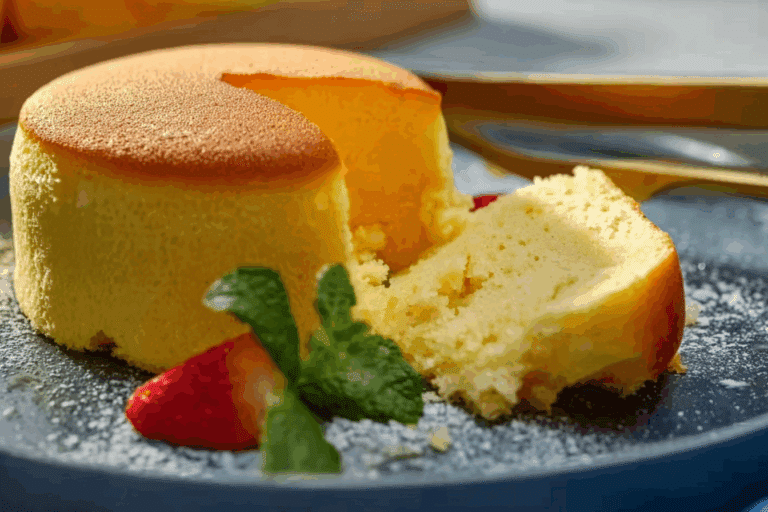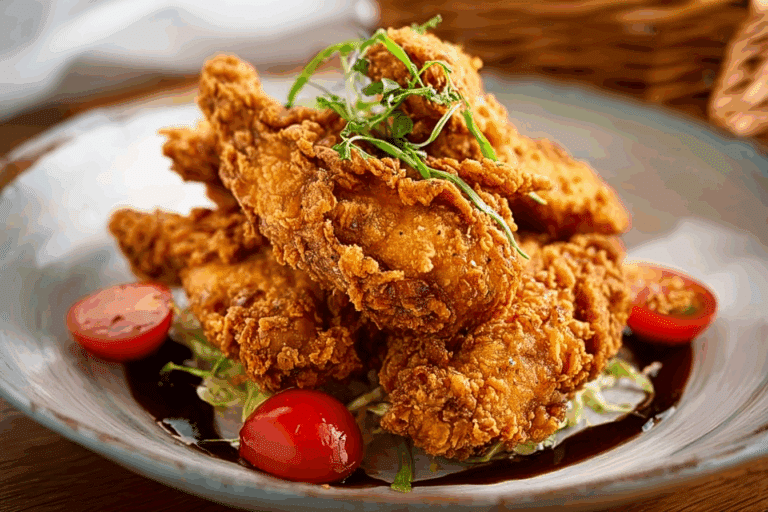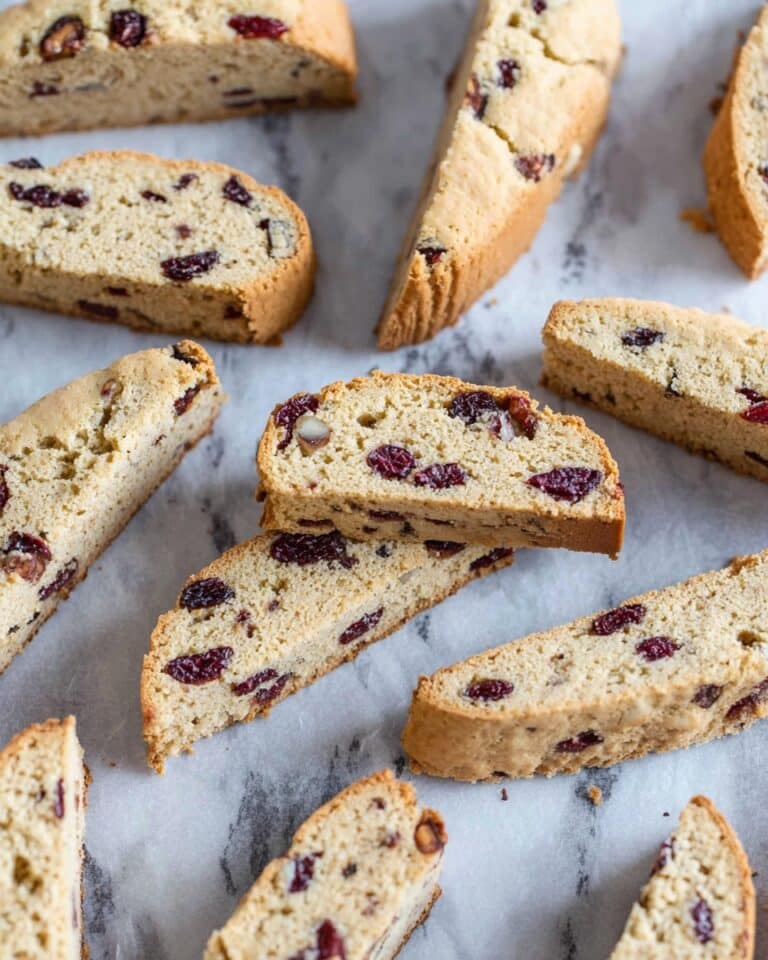Crusty Italian Bread Recipe
There’s something truly magical about fresh-baked bread with a golden, crackly crust and a soft, airy inside. This Crusty Italian Bread Recipe captures that magic perfectly. Whether you’re making it for a family dinner, a casual lunch, or just because you crave that authentic bakery feel at home, it’s incredibly rewarding to pull a piping hot loaf out of your oven.
What makes this Crusty Italian Bread Recipe so special is its simplicity paired with that amazing texture — crisp on the outside, tender and chewy on the inside. I love baking this bread when I want to impress guests or just treat myself. Plus, the ingredients are straightforward, so you won’t be overwhelmed and can focus on the fun part: kneading and smelling that irresistible aroma filling your kitchen.
Ingredients You’ll Need
Each ingredient here plays a key role in creating that perfectly crusty Italian loaf. From the bread flour giving structure to the yeast that helps our dough rise beautifully — I like to pick quality ingredients for the best results. Don’t skip on warm water; it’s crucial for activating the yeast just right!
- Bread Flour: This high-protein flour develops gluten well, essential for the chewy texture and crusty exterior you want.
- Warm Water: Around 100-110°F is perfect to activate your active dry yeast without killing it.
- Granulated Sugar: Feeds the yeast and helps the dough rise while adding a slight sweetness.
- Active Dry Yeast: Gives life to the dough by producing those lovely air pockets inside the bread.
- Butter: Adds richness and a subtle softness to the crumb—room temperature helps it incorporate smoothly.
- Salt: Enhances flavor and controls yeast growth for an even rise.
- Egg White: Used for brushing the crust, it promotes that beautiful glossy brown finish.
- Chilled Water: Mixed with egg white to delicately coat the loaf before baking.
- Extra Virgin Olive Oil: Adds a hint of fruity flavor and moisture on the crust’s surface.
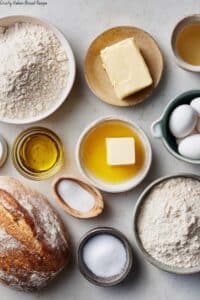
Variations
What’s fun about this Crusty Italian Bread Recipe is how easy it is to make your own tweaks. I sometimes experiment with adding herbs like rosemary or garlic powder right into the dough for extra flavor. Feel free to make it your own!
- Herb-Infused Variation: Adding fresh rosemary or thyme brightens the loaf and pairs nicely with olive oil dips—I adore this twist for weekend brunch.
- Whole Wheat Mix: Swap half the bread flour with whole wheat for a nuttier, heartier loaf, perfect if you want a bit more fiber.
- Gluten-Free Modification: Though trickier with this classic recipe, you can experiment with a gluten-free flour blend and xanthan gum, but expect a softer crust.
- Bold Seeds: Incorporating sesame or poppy seeds on top adds an appealing crunch and nutrition boost.
How to Make Crusty Italian Bread Recipe
Step 1: Activate the yeast
Start by dissolving 1 tablespoon sugar and 1 tablespoon active dry yeast in 1 3/4 cups of warm water (100-110°F). Give it a gentle stir and let it sit about 5-10 minutes until foamy and bubbly—this means your yeast is alive and kicking. I’ve made the mistake of skipping this step, thinking yeast was fresh, only to end up with flat bread, so don’t skip it!
Step 2: Mix the dough
In a large bowl, combine 650 grams bread flour (about 5 1/4 cups) and 2 teaspoons salt. Add softened butter and your activated yeast mixture. Mix well until a shaggy dough forms. This stage doesn’t have to be perfect; you’ll get it right once you knead.
Step 3: Knead until smooth and elastic
Turn the dough out onto a lightly floured surface, and knead away for about 10 minutes. I like to set a timer and knead with some upbeat music. You’re aiming for a dough that’s smooth and elastic, not sticky. If it sticks to your hands too much, sprinkle in a little flour—but be careful not to add too much or the bread will become dense.
Step 4: First rise
Place your dough in a large, lightly oiled bowl, cover it with a damp cloth or plastic wrap, and tuck it in a warm spot. It usually takes about 1 to 1 1/2 hours for the dough to double in size. When I wait patiently and let it rise properly, my bread bakes up much lighter and airier.
Step 5: Shape and second rise
After the dough has doubled, punch it down gently to release excess air. Shape it into a round loaf—don’t worry about being perfect. Place it on a parchment-lined baking tray. Cover and let it rise again for 30-45 minutes; this helps build that lovely crust later.
Step 6: Prepare the crust glaze
Mix 1 egg white with 1 tablespoon chilled water, then brush this mixture over the loaf. This step creates that highly desirable shiny, golden crust. For a finishing touch, drizzle on a little extra virgin olive oil right before baking.
Step 7: Bake to perfection
Preheat your oven to 425°F (220°C). Before placing the loaf in, you can spritz some water in the oven or add a pan of hot water on the rack below—the steam helps develop that crunchy crust. Bake for 25-30 minutes until the bread sounds hollow when tapped and has a deep golden crust. Let it cool on a rack for at least 20 minutes—resisting the urge to slice too early is tough, but worth it!
How to Serve Crusty Italian Bread Recipe

Garnishes
I love brushing the crust with extra virgin olive oil and sometimes sprinkling flaky sea salt on top right after baking—that touch adds so much flavor. Fresh herbs like basil or oregano also complement the bread beautifully when you serve it fresh from the oven.
Side Dishes
This crusty Italian bread pairs wonderfully with rustic tomato soup, hearty pasta dishes, and creamy dips like ricotta drizzled with honey. Personally, I like to serve it alongside a fresh Caprese salad or use it for dipping into balsamic olive oil—simple and delicious.
Creative Ways to Present
For special occasions, I slice the bread into thick slabs, drizzle with garlic-infused olive oil, and toast them to make bruschetta bases. It’s a hit at parties and feels so much more impressive than just plain bread. You could also hollow out the loaf and turn it into a rustic bread bowl for soups or dips.
Make Ahead and Storage
Storing Leftovers
I store leftover crusty Italian bread loosely wrapped in a paper bag inside a bread box or on the counter. This keeps the crust slightly crisp and prevents it from turning soggy. Avoid plastic wrap at room temperature, which traps moisture and softens your lovely crust.
Freezing
This bread freezes beautifully! I slice it first, then place slices in a freezer bag with parchment layers to avoid sticking. When you want some, just pull out a few slices instead of thawing the whole loaf. It’s a lifesaver for busy weeks.
Reheating
To revive that perfect crunch, I reheat slices in a toaster or in a preheated oven at 350°F for about 5-7 minutes. I’ve found microwaving tends to make crust rubbery, so the oven is my go-to if I want to maintain texture.
FAQs
-
Can I use all-purpose flour instead of bread flour for this Crusty Italian Bread Recipe?
Yes, you can substitute all-purpose flour, but the texture might be less chewy and slightly softer since it has less protein than bread flour. For the best crust and crumb texture, bread flour is recommended, but all-purpose flour still yields a tasty loaf.
-
How do I know if my bread is fully baked?
The best test is tapping the bottom of the loaf—it should sound hollow. Also, the crust should be deep golden and firm. Using an instant-read thermometer inside the loaf, about 190-200°F indicates it’s done.
-
Why is my bread not crusty after baking?
Crustiness depends on oven steam and baking times. Make sure to create steam in your oven by spritzing water or placing a pan of hot water inside during the first 10 minutes of baking. Also, don’t skip brushing with egg white mixture. Avoid wrapping the bread tightly right after baking, or it will soften the crust.
-
Can I make the dough in a stand mixer?
Absolutely! Use the dough hook attachment and mix on medium speed for about 8-10 minutes until the dough is smooth and elastic. It’s a great time-saver and especially helpful if you find kneading by hand tiring.
-
How long does homemade crusty Italian bread keep fresh?
At room temperature, the bread stays best for 2-3 days if stored properly in a paper bag or bread box. After that, it may start to dry out, so consider freezing leftovers for longer storage.
Final Thoughts
This Crusty Italian Bread Recipe is one of those kitchen wins that always feels worth the effort. I love how it fills my home with an inviting aroma and how it turns even the simplest meals into something special. Once you try it, you’ll have no problem making homemade bread a regular part of your cooking routine—no fancy equipment or complicated steps, just honest, delicious bread. Trust me, give this recipe a go and enjoy that perfect crusty crust with soft, flavorful crumb just like the best Italian bakery!
Print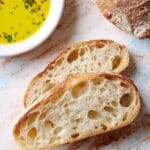
Crusty Italian Bread Recipe
- Prep Time: 15 minutes
- Cook Time: 30 minutes
- Total Time: 2 hours 30 minutes
- Yield: 1 large loaf (about 12 slices) 1x
- Category: Bread
- Method: Baking
- Cuisine: Italian
Description
This Crusty Italian Bread recipe yields a golden, crispy crust with a soft, airy interior. Made with simple ingredients like bread flour, warm water, yeast, and a touch of butter and sugar, this bread is perfect for sandwiches, dipping in olive oil, or serving alongside your favorite Italian dishes. The egg white wash adds a beautiful shine to the crust, while the slow rising process develops deep flavor.
Ingredients
Dough Ingredients
- 650 grams bread flour (approximately 5 1/4 cups)
- 1 3/4 cups warm water (100-110°F)
- 1 tablespoon granulated sugar
- 1 tablespoon active dry yeast
- 1 tablespoon butter, room temperature
- 2 teaspoons salt
Finishing Ingredients
- 1 egg white
- 1 tablespoon chilled water
- 1 tablespoon extra virgin olive oil
Instructions
- Activate the yeast: In a small bowl, combine the warm water (100-110°F), granulated sugar, and active dry yeast. Stir gently and let it sit for about 5-10 minutes until it becomes frothy, indicating the yeast is active.
- Mix the dough: In a large mixing bowl, combine the bread flour and salt. Add the softened butter. Pour in the yeast mixture and use a wooden spoon or your hands to mix until the dough comes together.
- Knead the dough: Transfer the dough onto a lightly floured surface and knead for about 8-10 minutes until smooth and elastic. If the dough is sticky, sprinkle a little more flour but avoid adding too much to keep the bread light.
- First rise: Shape the dough into a ball and place it in a lightly oiled bowl, turning once so all sides are coated with oil. Cover the bowl with a clean damp cloth or plastic wrap and let it rise in a warm draft-free place for 1 to 1 1/2 hours, or until doubled in size.
- Shape the loaf: After the dough has doubled, punch it down gently to release air. Transfer it to a floured surface and shape it into a loaf or oval shape as desired.
- Second rise: Place the shaped dough on a baking sheet lined with parchment paper or a lightly floured peel if using a baking stone. Cover loosely and let it rise again for 30-45 minutes until puffy.
- Preheat the oven: About 30 minutes before baking, preheat your oven to 450°F (230°C). If using a baking stone, place it in the oven to preheat as well.
- Prepare the egg wash: In a small bowl, whisk together the egg white and chilled water until slightly frothy. Brush this gently over the surface of the loaf to give it a glossy finish during baking.
- Add olive oil: Drizzle the tablespoon of extra virgin olive oil lightly over the top of the loaf for extra flavor and crispness.
- Bake the bread: Using a sharp knife or razor blade, score the top of the loaf with a few diagonal slashes to allow steam to escape. Place it in the oven on the middle rack (on baking sheet or stone) and bake for 25-30 minutes. The crust should be golden brown and crusty.
- Cool before slicing: Remove the bread from the oven and transfer it to a wire rack. Let it cool completely for at least 30 minutes before slicing to allow the crumb to set properly.
Notes
- Use bread flour for better gluten development and crust.
- Warm water temperature is important to activate yeast without killing it.
- Do not skip the egg white wash; it creates a beautiful glaze.
- For a more rustic texture, you can add a steam source in the oven by placing a pan with hot water at the bottom during baking.
- Store leftover bread wrapped in a clean kitchen towel to maintain crustiness.
Keywords: Italian bread, crusty bread, homemade bread, bread recipe, baking, yeast bread


